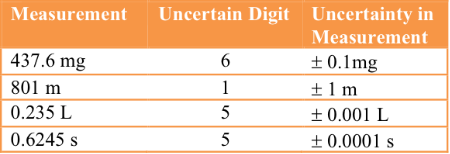We have familiarized ourselves with the units of measurement. We can now discuss what measurements are about. In order to proceed, there are two things we must know: 1) measurements are never exact, and 2) we need to know how well a measurement is made.
In regards to the first point, let’s consider what we mean by measurements are inexact. It seems to contradict the idea of scientists as perfectionists. When counting, we have exact numbers. There are twelve items in a dozen; there are 23 people in a room. These, as all counts, are exact numbers. But this doesn’t apply to measurements. For example, suppose we have to measure the length of a piece of metal using a meter stick which has centimeter increments.

Using this measuring stick, we can see that the piece of metal is definitely greater than four centimeters, but it’s less than five centimeters. We have to approximate the distance between the four and the five centimeters markings, which we will approximate as half way or about 0.5 centimeters, that is, 4.5 cm. As you can see, the 0.5 cm is not exact. It’s an approximation.
OK, so let’s try a meter stick with more increments, how about millimeter increments?

Using more increments in our measuring stick, we can now see that the measurement of the piece of metal is somewhere between 4.4 cm and 4.5 cm. Since it is halfway between we can estimate it as 0.05 cm. The measurement can be reported as 4.45 cm. Even though we have more increments to measure with, we still have uncertainty in the last digit of 0.01 cm. In the first measurement, it was the 0.5 cm that was estimated and the uncertainty in the measurement is 0.1 cm. In the second measurement there is uncertainty in the second decimal place and the uncertainty in the measurement is 0.01 cm. The point is, regardless of how many increments we have to measure with, there will always be a point of uncertainty in the measurement. The last digit in a measurement is always uncertain because it is an estimate, see table below. The precision of the measuring device is based on the number of increments on the measuring device. The use of the second measuring stick in our example gives a more precise measurement of 4.45 cm compared to that of the first measuring device that gives 4.5 cm.

There are two parts to the precision of a measurement: 1) how well a measurement can be repeated, and 2) the “fineness” of the measurement. By fineness, we mean the number of increments in the unit of measurement. We saw this in the previous examples such as using a meter stick with 1 cm intervals verses using one with millimeter intervals. For the most part, we can think of the fineness of the measurement as the amount of numbers, including the last uncertain number that the measuring instrument allows us. In following discussions and exercises, we will define precision according to the fineness of the measurement.
Accuracy and precision are two terms that many people think as interchangeable. Precision, as we just discussed, is regarded as both the fineness and repeatability of a measurement. Accuracy, on the other hand, is how close a measurement comes to an accepted or true value. Under normal conditions, water will boil at 100oC. But suppose a faulty thermometer measures the boiling water at only 98oC? The accuracy of the measurement is off. As another example, if a volume of 75 mL is required in an experiment, we can see that using a graduated cylinder with 0.1 mL increments will produce better accuracy than using one with 1 mL increments.
Exercises
1.What is the uncertainty in a measurement obtained from an electronic balance which displays a mass of 25.24 g?
2. A Student determined the following density data for an unknown metal: 4.62 g/mL, 4.63 g/mL, 4.62 g/mL, 4.61 g/mL. Comment on the precision and the accuracy of the measurements if the true density of the metal was 6.82 g/mL.
3. Consider the figure of the thermometer on the right to answer the following questions. 
Record the temperature _______.
What is the uncertain digit? ______
What is the uncertainty in the measurement? _______
CLICK HERE TO CHECK ANSWERS TO EXERCISES
Back to Study Guide List for General Chemistry I
Go To Home Page
